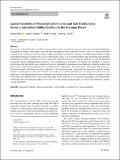Spatial variability of microbial communities and salt distributions across a latitudinal aridity gradient in the Atacama Desert
Abstract
Over the past 150 million years, the Chilean Atacama Desert has been transformed into one of the most inhospitable landscapes by geophysical changes, which makes it an ideal Mars analog that has been explored for decades. However, a heavy rainfall that occurred in the Atacama in 2017 provides a unique opportunity to study the response of resident extremophiles to rapid environmental change associated with excessive water and salt shock. Here we combine mineral/salt composition measurements, amendment cell culture experiments, and next-generation sequencing analyses to study the variations in salts and microbial communities along a latitudinal aridity gradient of the Atacama Desert. In addition, we examine the reshuffling of Atacama microbiomes after the rainfall event. Analysis of microbial community composition revealed that soils within the southern arid desert were consistently dominated by Actinobacteria, Chloroflexi, Proteobacteria, Firmicutes, Bacteroidetes, Gemmatimonadetes, Planctomycetes, and Acidobacteria, and Verrucomicrobia. Intriguingly, the hyperarid microbial consortia exhibited a similar pattern to the more southern desert. Salts at the shallow subsurface were dissolved and leached down to a deeper layer, challenging indigenous microorganisms with the increasing osmotic stress. Microbial viability was found to change with aridity and rainfall events. This study sheds light on the structure of xerotolerant, halotolerant, and radioresistant microbiomes from the hyperarid northern desert to the less arid southern transition region, as well as their response to changes in water availability.
Citation
Shen , J , Wyness , A , Claire , M & Zerkle , A 2021 , ' Spatial variability of microbial communities and salt distributions across a latitudinal aridity gradient in the Atacama Desert ' , Microbial Ecology , vol. First Online . https://doi.org/10.1007/s00248-020-01672-w
Publication
Microbial Ecology
Status
Peer reviewed
ISSN
0095-3628Type
Journal article
Description
This research was funded by European Research Council (ERC) under the European Union’s Horizon 2020 Research and Innovation Programme (Grant Agreement 678812) (to MWC) for 2017 sampling and various geochemical characterizations, and John Templeton Foundation (Grant Agreement 60501) (to AJW) for assistance with sequencing and bioinformatics. J.S. also acknowledges support from the China Scholarship Council (CSC).Collections
Items in the St Andrews Research Repository are protected by copyright, with all rights reserved, unless otherwise indicated.

